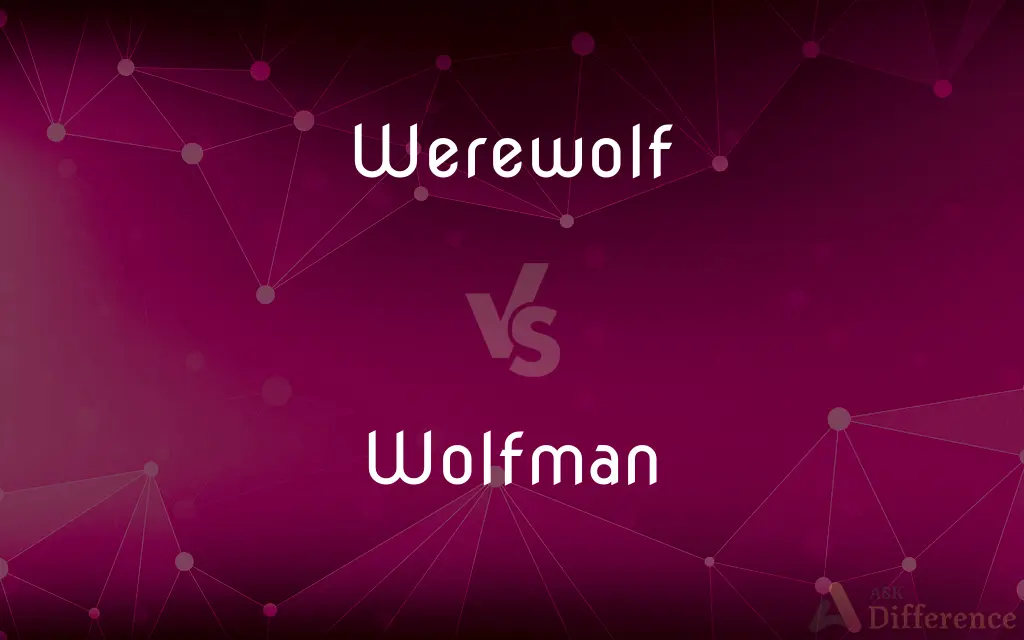Werewolf vs. Wolfman — What's the Difference?
By Tayyaba Rehman — Updated on October 12, 2023
Werewolf is a person who transforms into a wolf at the full moon. Wolfman is a human with wolf-like features but doesn't necessarily transform.

Difference Between Werewolf and Wolfman
Table of Contents
ADVERTISEMENT
Key Differences
A Werewolf is a mythical creature originating from European folklore, typically depicted as a human who transforms into a wolf during a full moon due to a curse or affliction. The Wolfman, on the other hand, is often portrayed as a human who possesses wolf-like characteristics, but does not undergo a transformation.
While the Werewolf's metamorphosis is often involuntary, driven by lunar cycles or specific triggers, the Wolfman remains static in his half-human, half-wolf state. Both the Werewolf and Wolfman are prominent figures in horror literature and film, yet their portrayals differ.
A Werewolf is frequently shown as struggling with their dual identity, trying to reconcile their human nature with the beast within. Conversely, the Wolfman, while also experiencing conflict, is more of a fusion between man and wolf, blending the traits of both species.
Ultimately, while both the Werewolf and Wolfman symbolize the wildness within humanity, the Werewolf emphasizes transformation and duality, whereas the Wolfman embodies a constant melding of the human and the beastly.
Comparison Chart
Origin
European folklore
Modern media and fiction
ADVERTISEMENT
Transformation
Transforms into a wolf during the full moon
Does not transform; always in a half-wolf state
Appearance
Human by day, wolf by night
Constant hybrid of human and wolf features
Control
Often lacks control during transformation
Retains human consciousness and control
Literary Symbolism
Duality and internal struggle
Fusion of man's primal and civilized sides
Compare with Definitions
Werewolf
A person who changes into a wolf at full moon.
Every full moon, the villagers feared the appearance of the Werewolf.
Wolfman
A man with wolf-like characteristics.
In the shadows, the Wolfman lurked, watching the camp.
Werewolf
A representation of man's primal instincts and duality.
The protagonist's inner Werewolf represented his struggle with his darker desires.
Wolfman
A permanent blend of man's and wolf's features.
The Wolfman's howl was both human and haunting.
Werewolf
A lycanthrope, subject to transformation due to a curse.
He realized too late that the bite had turned him into a Werewolf.
Wolfman
A fusion of human and wolf without the element of transformation.
Unlike werewolves, the Wolfman remained in his hybrid form.
Werewolf
A mythical creature cursed to shift between human and wolf.
Legends spoke of a Werewolf who haunted the woods.
Wolfman
A figure from horror media, representing a blend of the primal and the human.
Films often depicted the Wolfman as both a threat and a tragic figure.
Werewolf
A being from folklore, battling between their human and animalistic nature.
The story of the Werewolf is one of tragedy and conflict.
Wolfman
An individual who embodies the traits of both humans and wolves.
The legend spoke of a Wolfman, neither fully man nor wolf.
Werewolf
In folklore, a werewolf (Old English: werwulf, "man-wolf"), or occasionally lycanthrope (Greek: λυκάνθρωπος lukánthrōpos, "wolf-human"), is a human with the ability to shapeshift into a wolf (or, especially in modern film, a therianthropic hybrid wolflike creature), either purposely or after being placed under a curse or affliction (often a bite or scratch from another werewolf) with the transformations occurring on the night of a full moon. Early sources for belief in this ability or affliction, called lycanthropy , are Petronius (27–66) and Gervase of Tilbury (1150–1228).
Wolfman
A werewolf or lycanthrope.
Werewolf
A person believed to have been transformed into a wolf or to be capable of assuming the form of a wolf.
Wolfman
A monster able to change appearance from human to wolf
Werewolf
(mythology) A person who is transformed or can transform into a wolf or a wolflike human, often said to transform during a full moon. Category:en:Horror
Werewolf
A person transformed into a wolf in form and appetite, either temporarily or permanently, whether by supernatural influences, by witchcraft, or voluntarily; a lycanthrope. Belief in werewolves, formerly general, is not now extinct.
The werwolf went about his prey.
The brutes that wear our form and face,The werewolves of the human race.
Werewolf
A monster able to change appearance from human to wolf
Common Curiosities
Can Werewolves control their transformation?
Often, Werewolves have no control over their transformation and actions during it.
What's the primary difference between a Werewolf and Wolfman?
A Werewolf undergoes transformation, while a Wolfman does not.
What's a Werewolf?
A Werewolf is a person who transforms into a wolf, usually during the full moon.
Does the Wolfman transform like a Werewolf?
No, the Wolfman remains in a constant state, blending human and wolf features.
Can a Werewolf be cured?
Folklore and stories vary, but some suggest certain rituals or acts can cure a Werewolf.
How does a Werewolf transform?
A Werewolf typically transforms under the influence of the full moon or due to a curse.
Is the Wolfman based on ancient legends like the Werewolf?
No, the Wolfman is more a product of modern media and fiction than ancient legends.
Can a person become a Werewolf by being bitten by one?
According to many legends and stories, a person bitten by a Werewolf can become one.
What is a Wolfman?
A Wolfman is a humanoid creature with wolf-like features, without undergoing a transformation.
Where does the concept of the Werewolf originate?
The concept of the Werewolf originates from European folklore.
Is the Wolfman's appearance constant?
Yes, the Wolfman retains a consistent half-human, half-wolf appearance.
What's the symbolism behind the Werewolf?
The Werewolf often symbolizes duality, internal struggle, and man's primal instincts.
How is the Wolfman typically portrayed in media?
The Wolfman is often shown as a tragic figure, representing a blend of the primal and the human.
Are there similarities between the Werewolf and Wolfman?
Yes, both represent a blend of human and wolf, but the nature and dynamics of this blend differ.
Is the Wolfman considered a type of Werewolf?
No, while they share similarities, they're distinct entities with different characteristics and lore.
Share Your Discovery

Previous Comparison
Gentleman vs. Lady
Next Comparison
Warp vs. WharpAuthor Spotlight
Written by
Tayyaba RehmanTayyaba Rehman is a distinguished writer, currently serving as a primary contributor to askdifference.com. As a researcher in semantics and etymology, Tayyaba's passion for the complexity of languages and their distinctions has found a perfect home on the platform. Tayyaba delves into the intricacies of language, distinguishing between commonly confused words and phrases, thereby providing clarity for readers worldwide.














































